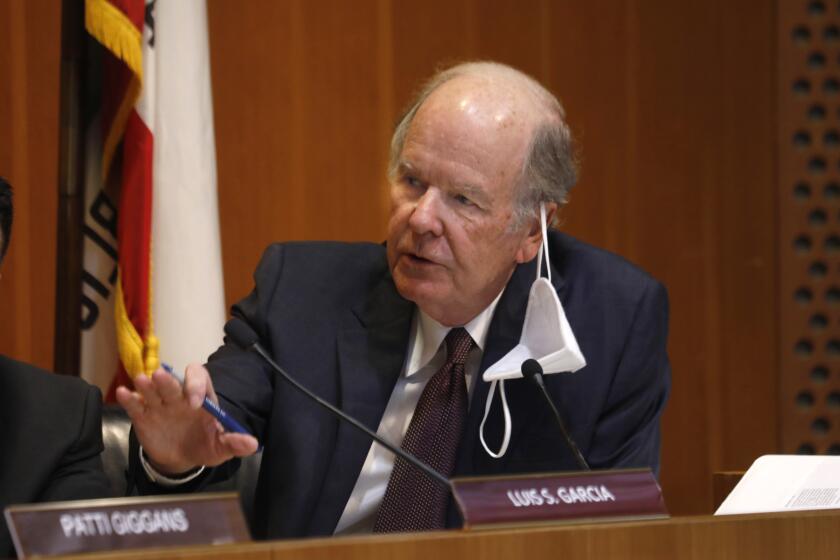L.A.’s River clears hurdle
- Share via
U.S. EPA Administrator Lisa Jackson on Wednesday declared the entire concrete-lined Los Angeles River channel “traditional navigable waters,” a designation crucial to applying Clean Water Act protections throughout its 834-square-mile urban watershed.
“We’re moving away from the concrete,” Jackson told more than 200 residents and government officials on the banks of one of the river’s heavily polluted tributaries, Compton Creek.
“This is a watershed as important as any other,” she said. “So we are going to build a federal partnership to empower communities like yours .... We want the L.A. River to demonstrate how urban waterways across the country can serve as assets in building stronger neighborhoods, attracting new businesses and creating new jobs.”
The decision may seem odd to people who know the L.A. River as a flood-control channel of treated water a few inches deep flowing between massive, graffiti-marred concrete banks strewn with rotting garbage and broken glass, and occasionally polluted with chemicals illegally dumped in storm drains and gutters that empty into it.
Jackson said the EPA considered factors beyond whether the river’s flow and depth can support navigation from its origins at the confluence of the Arroyo Calabasas and Bell Creek in the San Fernando Valley all the way to San Pedro Bay, a distance of about 51 miles.
Among other considerations, EPA officials said, were recreational and commercial opportunities, public access, susceptibility to restoration, and the presence of ongoing restoration and educational projects.
The designation overturned an earlier ruling by the Army Corps of Engineers that only four miles of the river were navigable, which would have made it easier to develop its upper reaches by eliminating the need for certain federal permits.
“This is an important day, one we’ve been working toward for years,” said poet and writer Lewis MacAdams, founder of Friends of the Los Angeles River. “It is a day when the EPA has essentially redefined the L.A. River and its values. In other words, starting today, a flood control channel is only one of its many characteristics.”
David Beckman, senior attorney at the Natural Resources Defense Council, suggested that the shift could affect the way many other river systems are managed.
“The EPA’s decision has been closely watched as an indicator of whether similar rivers throughout the West -- dry as a bone one day, a torrent the next -- would lose historical protections under the Clean Water Act,” he said. “So this is great news. It means less pollution in the river and provides a vital support for community efforts to rejuvenate and restore it.”
Los Angeles County Supervisor Mark Ridley-Thomas would not argue with any of that. At the news conference he announced the purchase of a four-acre portion of the Compton Creek riverbed devastated by decades of storm runoff and illegal dumping.
The stretch of creek bed choked with foliage and trash was bought from the nearby Crystal Casino and Hotel with $1.5 million of Proposition 8 funds in an arrangement led by Ridley-Thomas and partners including the environmental group Heal the Bay, the EPA, L.A. County and the city of Compton. The creek bottom is now controlled by a joint powers entity of the San Gabriel and Lower Los Angeles Rivers and Mountains Conservancy. Public ownership of this parcel will allow for prompt restoration, Ridley-Thomas said.
“We are now launched on a project that will significantly improve the quality of life of the people of Compton and adjacent communities,” he said. “I am calling for an ecosystem restoration study of Compton Creek. In the near term, we can look at developing pedestrian and bike access.”
It was unclear whether the EPA’s announcement would prompt Los Angeles County flood control officials to alter maintenance operations along an 8-mile stretch of Compton Creek, including annual bulldozing of debris and vegetation.
County authorities contend that the operations are needed to protect lives and property during storm season along the creek, which runs through several cities en route to the L.A. River. Compounding problems, the channel’s levee systems do not meet federal standards.
Mark Pestrella, deputy director of the Los Angeles County Department of Public Works, said the EPA’s decision “opens the door for the federal government to use habitat restoration, for example, as a value that must be taken into account when competing for dollars for various projects.”
Among those listening at the news conference was Heather Wylie, a former project manager in the Ventura field office of the Army Corps of Engineers, who lost her job after kayaking down a stretch of the L.A. River in late 2008.
The expedition was in protest of the agency’s ruling that year that only a small portion of the river was boat-worthy. She was suspended from her duties and eventually left the agency.
“All I did was go kayaking to make a point about Clean Water Act protections,” she said. “I am grateful for the EPA stepping in and fixing this.”
More to Read
Sign up for Essential California
The most important California stories and recommendations in your inbox every morning.
You may occasionally receive promotional content from the Los Angeles Times.














